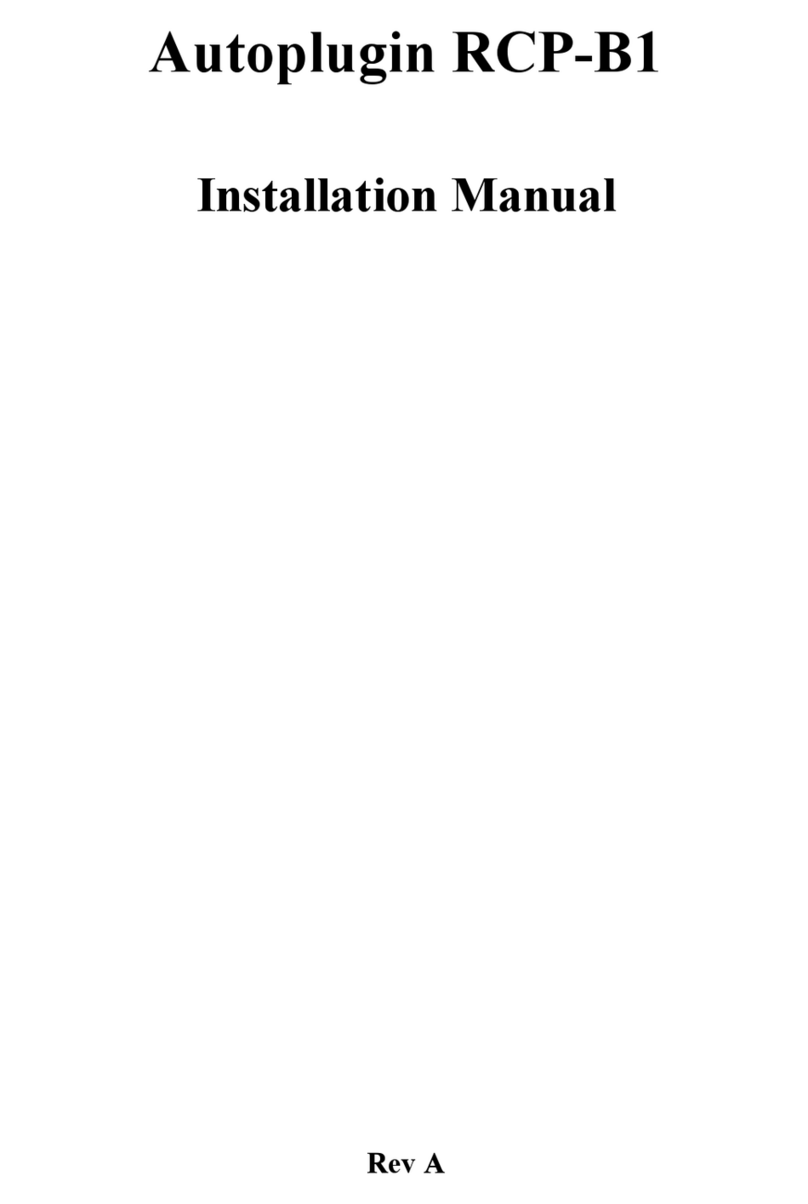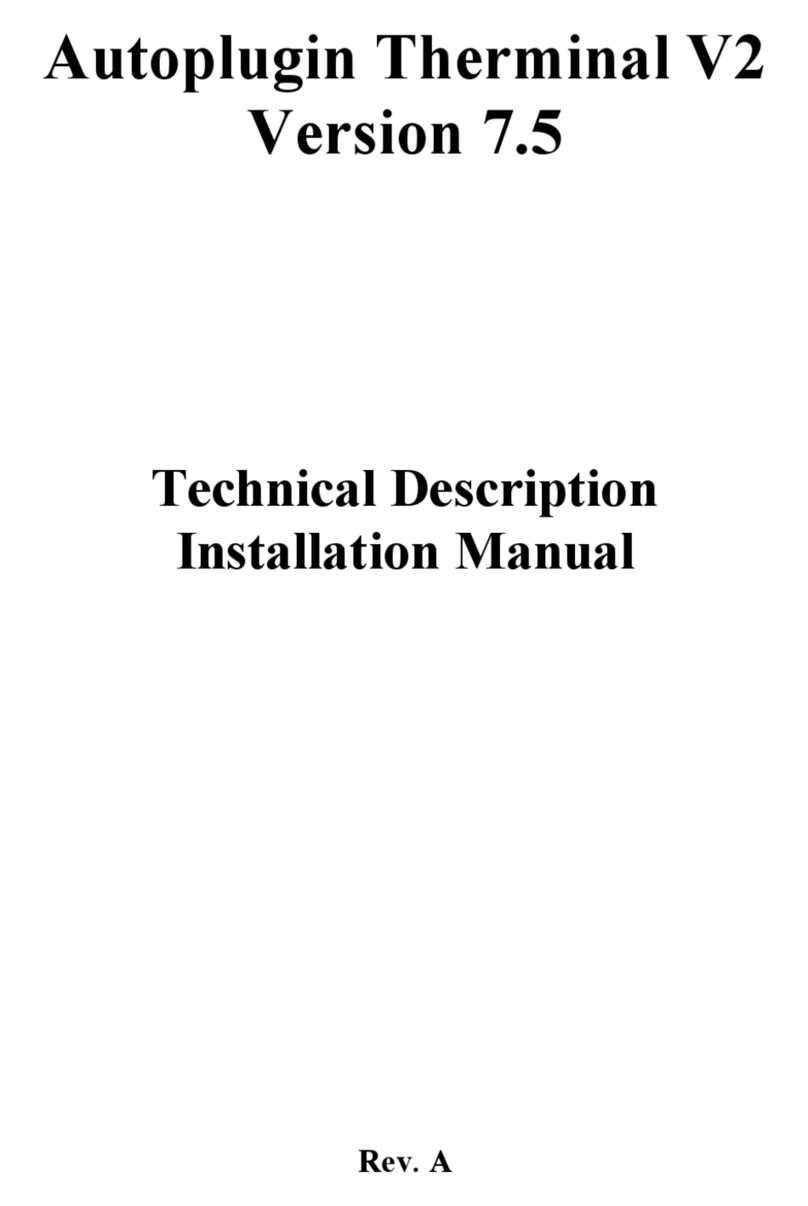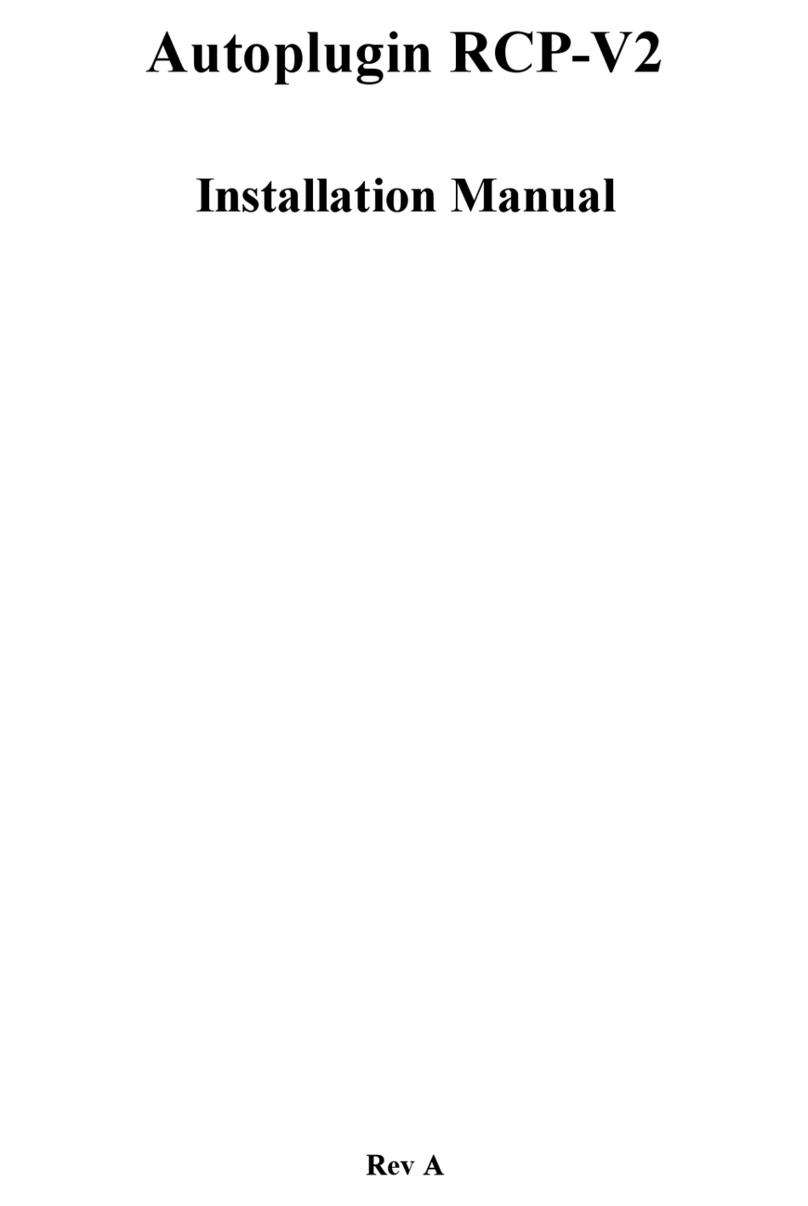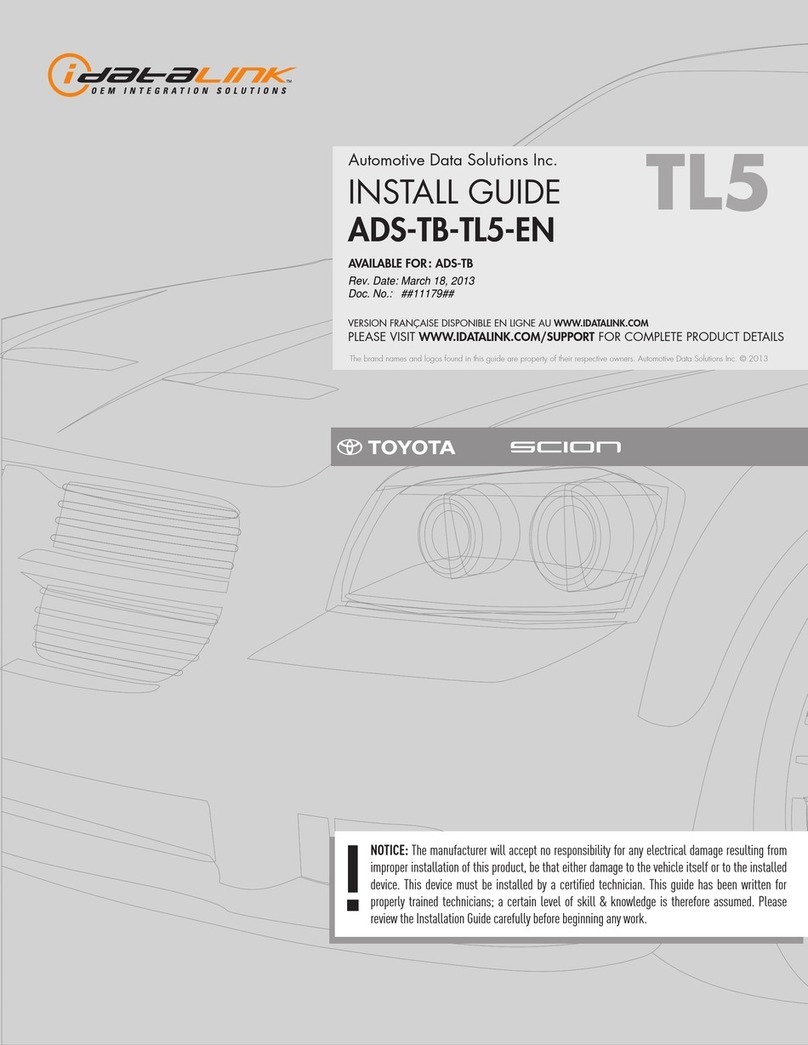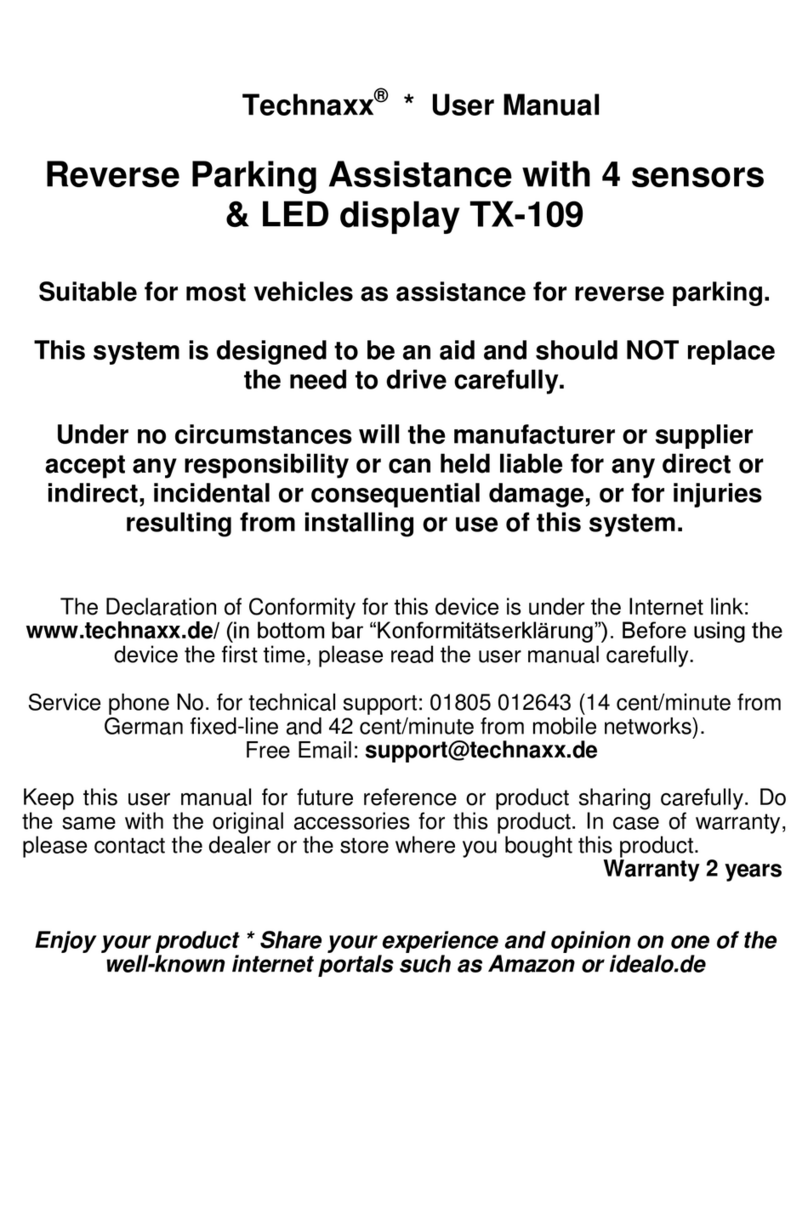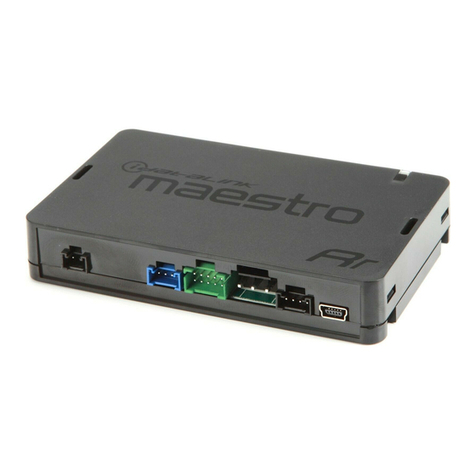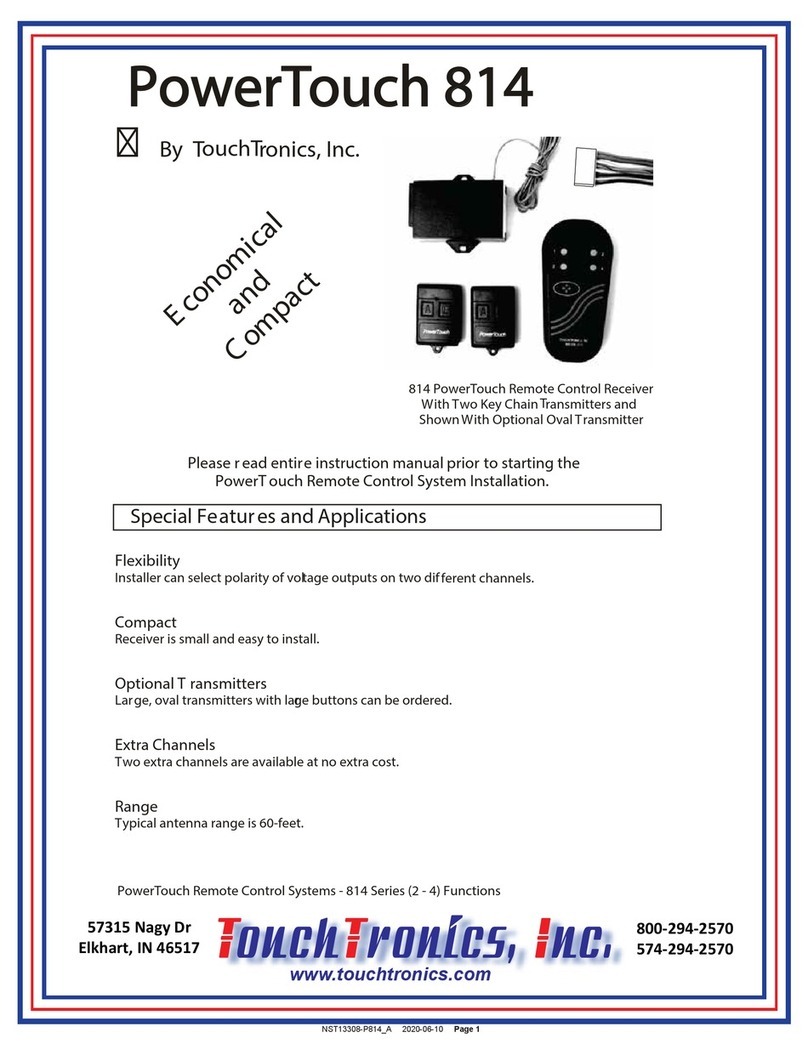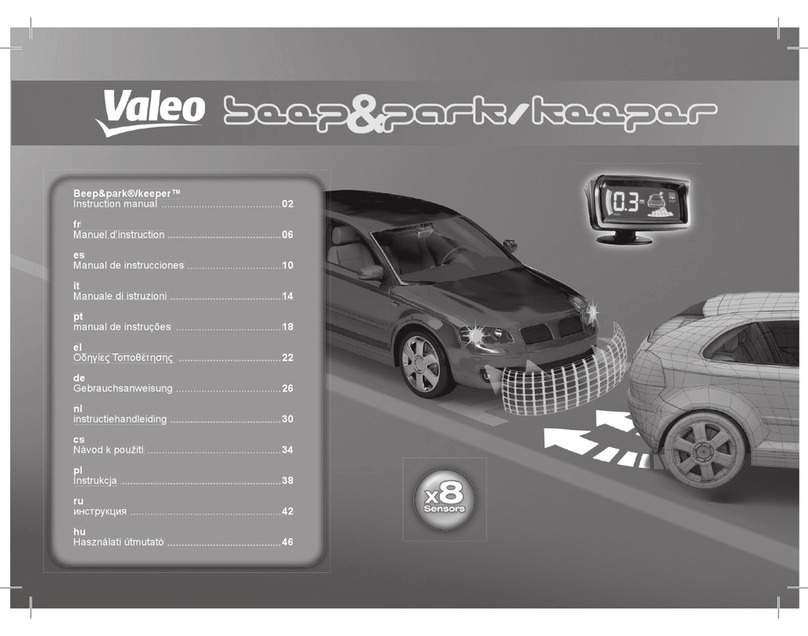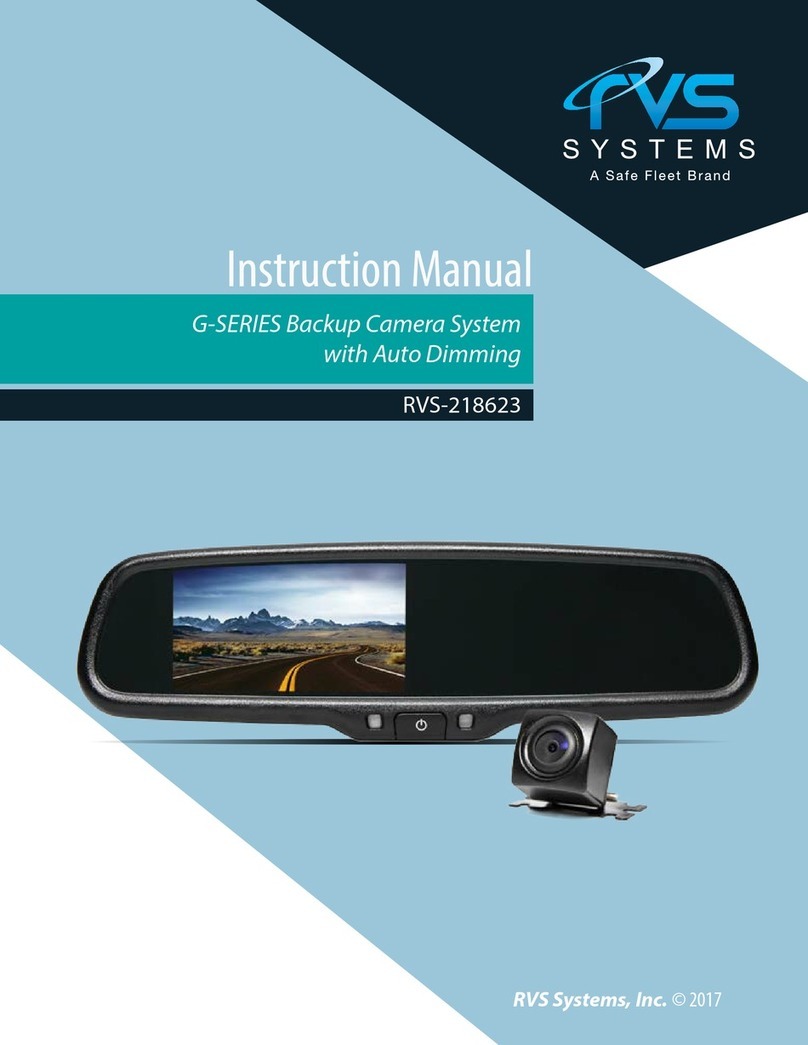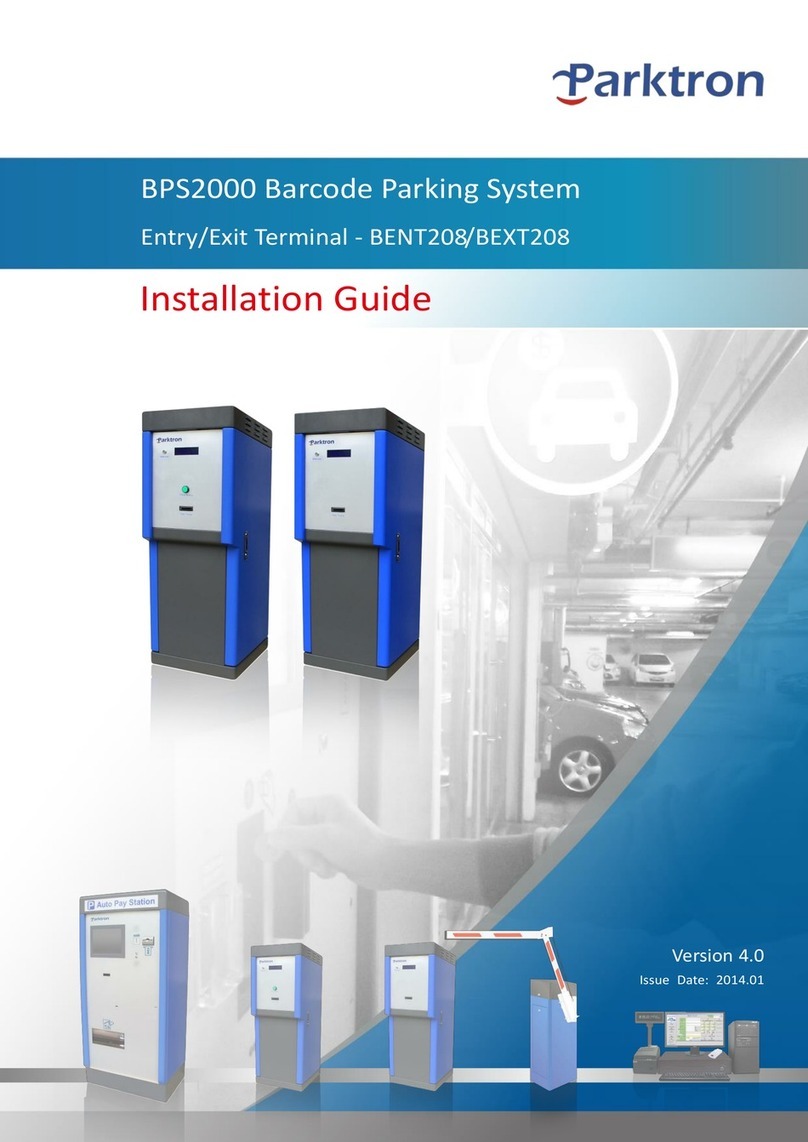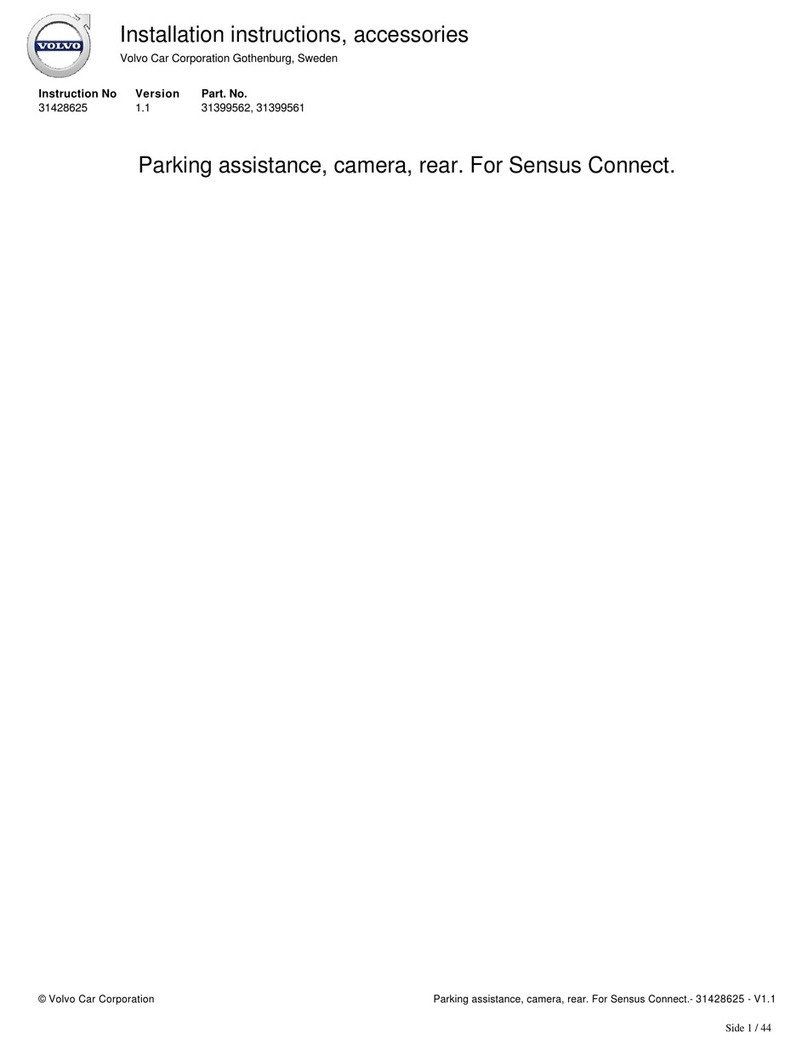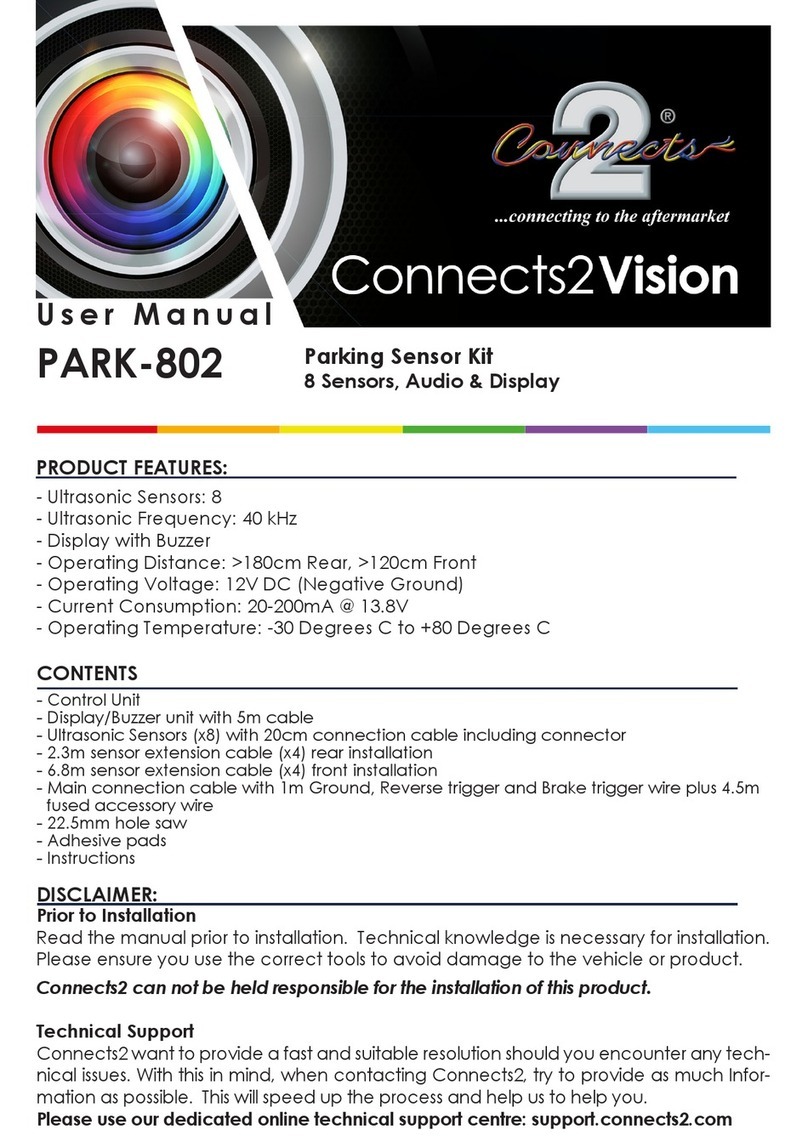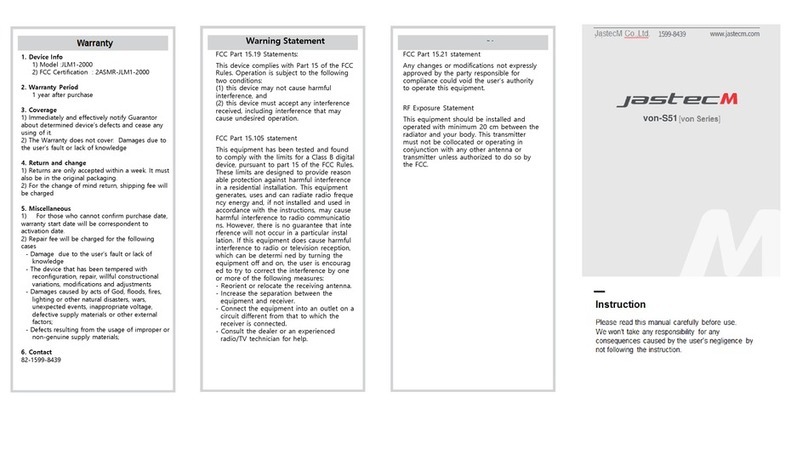Autoplugin RCP-F2 User manual

Autoplugin RCP-F2
Version 7.3
Technical Description
User Manual
Rev. A

2
Table of Contents
Description………………………...………………………………….……………2
Module Possibilities………………………………………………………………..2
Package Content……………………………………………………………………2
Signals………………………………………………………………………...……3
Connection…………………………………………………………………………5
Preparation for Work……………………………………………………………….6
Basic Functions…………………………………………………………………….6
Additional Functions………………………………………………………….……8
Troubleshooting………………………………………………………………...…13
Glossary…………………………………………………………………………...15
Description
The Autoplugin RCP-F2 module is intended for remote control connection to the
fuel-fired heater (parking heater, fuel operated heater, pre-heater), factory installed
in Ford Focus 2 (2004-2011), Ford С-Max (2003-2010) or Ford Kuga (2008-
2012). The device controls the heater via CAN-bus.
Module Possibilities
·Heater control by various impulses
·Heater status signals outputs
·Embedded remote control of the heater by using the original 3-button
Ford car’s key
·Remote cancellation of heater startup, programmed in the driver
information system
·Indication of successful/unsuccessful start and of autonomous operation
of the heater with the direction indicators in rear-view mirrors.
·Extended boost heat mode control
·Main battery protection from discharging by inspecting of voltage level
and heater operation time
·Heater errors clearing (unblocking)
Package Content
1. Autoplugin RCP-F2 (0101-1110) module
2. Wiring for permanent connection
3. Plug-n-Play cable
4. Technical description brochure
5. Installation manual brochure

3
Signals
The module has two connectors: 9-pin connector X1 (table 1) for input signals and
power connection, 10-pin connector X2 (table 2) for output signals, special signals
and CAN-bus connection. The first pin on each connector is marked by the key.
X1.1 Heater_off+
1
The input can be used to switch off the heater, operated in pre-heat mode, by the
impulse of positive polarity (the input Heater_off- in that case has to be connected
to the Ground). The heater is stopped by the leading edge of the impulse. If the
heater is idle, positive impulse on this input cancels the program start of the heater,
programmed by DIS.
Table 1
X1 pin
number
Signal Name
Polarity
Wire colour
1
Heater_off+
+
White
2
Heater_off-
-
Grey
3
Heater_on+
+
Green
4
Heater_on-
-
Blue
5
Button
-
Brown
6
Boost
+
Orange
7
RC_in
+
Yellow
8
Ground
Black
9
Battery Power
Red
The signals to be necessarily connected marked in Italics
Table 2
X2 pin
number
Signal Name
Polarity
Wire colour
Maximum
Electric Load*,
mА
1
RC_out
+
Blue-white
500
2
Heater_Status
-
Yellow
500
3
Alert_1
-
Grey
500
4
Alert_2
-
Orange
500
5
Timer_out
-
Blue
500
6
Indication
+
Red-white
1000
7
Sensor_In
-
Green-yellow
8
Sensor_Out
-
Green
500
9
CAN-L
Brown-white
10
CAN-H
Brown

4
*The connection of outputs 2-5 directly to the Power, without a load, is not
permitted. The connection of outputs 1 and 6 directly to the Ground, without a
load, is not permitted
The signals to be necessarily connected marked in Italics
X1.2 Heater_off-
1
The input can be used to switch the heater off, operated in pre-heat mode, by the
impulse of negative polarity (the input Heater_off+ in that case has to be
connected to the Power). The heater is stopped by the leading edge of the impulse.
If the heater is idle, negative impulse on this input cancels the program start of the
heater, programmed by DIS. This input is suitable for the most alarm systems and
GSM-modules connections in order to control the heater remotely.
X1.3 Heater_on+
1
The input can be used to switch the heater on by the impulse of positive polarity
(the input Heater_on- in that case has to be connected to the Ground). The heater
is started by the leading edge of the impulse.
X1.4 Heater_on-
1
The input can be used to switch the heater on by the impulse of negative polarity
(the input Heater_on+ in that case has to be connected to the Power). The heater is
started by the leading edge of the impulse. This input is suitable for the most alarm
systems and GSM-modules connections in order to control the heater remotely.
X1.5 Button
The input for multi-functional button connection. The current function of the
button depends on heater status, ignition status and engine status (see Table 4 for
more details)
X1.6 Boost
The input for external control of boost heat mode. It enables or disables boost heat
mode depending on setting 1.1. External switch can be connected to the Boost
input in order to quick manage of boost heat mode.
X1.7 RC_in
The input can be used to switch the heater on/off by the impulse of positive
polarity. The heater is turned on by the leading edge of an impulse and is turned off
by the trailing edge of the impulse. The specialized remotes such as Smart Start,
Easy Start and Telestart can be connected to this input
1
. GSM-modules with a
potential signal on the control channel also may be connected to the input.
X1.8 Ground
1
X1.9 Power +12V
1
X2.1 RC_out
The output is used to inform Defa VU module that the heater has been switched
off. When the heater is switched off, the impulse of positive polarity with 0.5
second duration appears on the output. When the engine is running, the output is
permanently pulled up to the Power. This signal is used for Defa Smart Start only.

5
X2.2 Status
The assignment of this output is defined by the setting 7.5. By default the signal
“Heater operates autonomously” is given on the output.
X2.3 Alert_1
The signal is used to send a notification to remote control (RC should be capable to
receive alerts). The assignment of this output is defined by the setting 7.3. When
programmed event is occurred, the impulse of negative polarity with 1 second
duration appears on the output. By default the signal “Heater started” is given on
the output.
X2.4 Alert_2
The signal is used to send a notification to remote control (RC should be capable to
receive alerts). The assignment of this output is defined by the setting 7.4. When
programmed event is occurred, the impulse of negative polarity with 1 second
duration appears on the output. By default the signal “Heater stopped” is given on
the output.
X2.5 Timer_out
The output can be used to control an external device by time of heater operation.
Time of signal appearing is defined by the setting 5.1. When the heater operates for
programmed time, the impulse of negative polarity with 1 second duration appears
on the output.
X2.6 Indication
The output can be used for connection of stand alone or button built-in indicator,
which will inform user about heater run-time errors.
X2.7 Sensor_In
Not used
X2.8 Sensor_Out
Not used
X2.9 CAN-L
Low-level CAN bus line has to be connected to the blue wire of Medium Speed
CAN bus
1
.
X2.10 CAN-H
High-level CAN bus line has to be connected to the grey wire of Medium Speed
CAN bus
1
.
1
- See installation manual for connection details
Connection
RCP gives a possibility of quick connection to the OBD-II service connector by
using supplied Plug-n-Play cable. Professional installation is recommended for
connection of additional remote control. It needs at least some experience in car
electronics installation. See installation manual for detailed connection schemes for
various remotes.

6
Preparation for Work
·Focus II (2004-2007), C-Max (2003-2006)
Turn on the ignition and select in driver information system (DIS) menu:
Your settings -> Aux.heater programming ->Instant control -> Auto
·Focus II (2008-2011), C-Max (2007-2010), Kuga
Start the engine and select in DIS menu:
Set>Menu –> Settings –> Auxiliary Heating -> On ->Off ->On (again)
Basic Functions
1. To start/stop the heater by using additional remote control, see
documentation for the remote control. Functionality of the remote control
depends on its possibilities, connection schemes and module’s settings.
2. To start the heater by using the original Ford key press “Lock” button 3
times on the key. Time intervals between presses must not exceed 20
seconds. The unlocking of the vehicle or time interval excess will restart the
counter of “Lock” button presses. Look at the direction indicators to be sure
that RCP has received a command from the key. Every button press on the
key will be confirmed by direction indicators (if the car has been locked
before). Also if the car equipped by keyless entry system, you can use
button on the door handle as “Lock” button to start the heater outside the car
(passive key must be presented). You can see series of double flashes in
direction indicators of rear-view mirrors when the heater starts to operate
(choose setting 6.1.2 to activate this function).
3. The RCP adjusted by default only to switch the heater on by using Ford key.
If you also wish to switch the heater off, change the setting 5.1. As both the
commands use the same combination of “Lock” presses, you should know a
condition of the heater before a command send. Therefore we recommend
you to activate the settings 6.4 – 6.6 to see the heater condition indicated by
turn signals flashing in the rear-view mirrors. The possibility to stop the
heater remotely may be useful in case of cancelation of the trip, including
ones programmed by DIS.
4. You can remotely cancel the start of the heater by a DIS program, if your
additional remote control can send stop command when the heater is idle.
After stop command sending, DIS programs will be temporary disabled.
Start the heater by any way or turn the ignition on enables DIS programs
again.
5. Additionally connected button gives several functions. Current function is
defined by heater, ignition and engine conditions (see table. 3)
When the ignition is turned off, the button is used for immediate start or
stop of the heater. Button press changes heater condition to another one:
switches off the operated heater or switches on the idle heater.

7
When the ignition is turned on, button pressing keeps the current
condition of the heater after the engine start. So, if the heater has operated
before the engine start, it may continue to operate after the engine start (in boost
heat mode). If the heater has been idle before the engine start, button press will
inform RCP doesn’t let the heater to start in boost heat mode after the engine
start. These functions are called quick enabling and disabling of boost heat
mode respectively. Being activated these functions act for the current ignition
cycle. Turning the ignition off cancels these functions.
Table 3
Button function
Ignition
status
Engine
status
Heater
status
Description
(how to use)
Heater immediate
start
Off
Not running
Off
One-touch heater start
Heater immediate
stop
Off
Not running
On
One-touch heater stop
One-time boost
disable
On
Not running
Off
Quick disabling of boost
heat mode for short trips
One-time boost
enable
On
Not running
On
Quick enabling of boost
heat mode in case of boost
heat mode disabling by
RCP settings or in case of
one-time disabling by the
button pressing
On
Running
Off
Boost extension
On
Running
On
This function lets the heater
keep working after the
engine has been switched
off. It is useful with short
stops in a trip.
When the engine runs, the button press is used to quickly enable of the
boost heat mode (if boost heat mode was disabled early) and for the function
called Boost Extension (if the heater operates in boost heat mode). Usually the
heater is turned off right after the engine stops. If you want stop the engine with
the heater keep working, you may use this button function. Boost extension
once activated will act while don’t you stop the heater manually or the heater
stops automatically when the coolant achieves working temperature.
Warning! The parking heater must not be operated at filling stations, near
sources of combustible vapours or dust or in enclosed spaces
The fuel fired heater needs about 3 minutes to go to normal operation
after startup. If your trip is planned to be shorter, it is highly recommended to
use a button function called “one-time boost disable”. This preserves the heater
from premature clogging. Turn on the ignition, press the button, then start the

8
engine. Now the heater will not operate with the engine while don’t you turn the
ignition off or use “one-time boost enable” function.
Additional Functions
By default RCP adjusted to perform only basic functions, such as start and
stop the heater using the remote control key. To turn on additional functions such
as battery monitoring, flashing with direction indicators in rearview mirrors, etc.
enter the module into Setup mode and activate the corresponding setup item (see
settings table 2).
A programming button and the brakes pedal are used to enter setup mode
and to change settings. You can use either additionally installed button, or front
passenger’s window close button on the driver’s door control panel as
programming button. Some car versions not allow using power window control
button as programming button. Use additional button in that case.
It is necessary to stop the engine and the heater before. Turn the ignition on,
press and hold the brakes pedal. Then 3 times press the programming button (press
and hold additional button for about 1.5 seconds, until the LED goes out). Both
direction indicators in the DIS confirm entering to the setup mode with 2 flashes.
Release the brakes pedal finally.
Each setup item in the settings table is a 3-digit code. To enter a digit of a
code, shortly press the button so much times, as corresponds to a digit. The LED
and the direction indicators symbols in the DIS confirm each button press: the
LED briefly goes off, the left direction indicator flashes one time when the first or
the third digit of code entered, the right direction indicator - when the second digit
of code entered. To complete a digit entering, press and release brakes pedal. The
DIS confirms it with one flash of both direction indicators simultaneously. When
all three digits entered, the module checks the code for validity and confirms it
with the direction indicators flashing. The both direction indicators flash twice
simultaneously in case of valid code and flash twice alternately in case of invalid
code.
If entered digit is not correct, press and release brakes button until the module
indicates an error. Enter the code once more in that case. Several codes can be
entered without exit of setup mode.
Turn the ignition off to exit setup mode. New settings are saved in the nonvolatile
memory of the module and stored there regardless of whether the module is
connected or not. Attention: If you start the engine without exit Setup mode, new
settings will not be saved in memory.
To reset the module to the factory settings, enter the code 8.1.1. Both direction
indicators in the CIP should flash three times, confirming command execution.
Then the module exits Setup mode and restarts.
To clear all the errors in the heater’s memory and thus unblock the heater, enter the
code 9.1.1. Both direction indicators flash five times confirming errors clearing. If

9
unblocking of the heater is impossible, the indicators flash five times alternatively.
Pay attention: when you apply unblocking function for the first time, RCP
remembers VIN code of the car. In the future unblock function will work only for
this car.
Settings Table (4)
1. Boost
Heat Mode
Control
1.1. Additional
engine heating in
boost heat mode
1.1.1 *Enabled by the module. Active level
on X1.6 disables the boost heat mode
1.1.2 Disabled by the module. Active level
on X1.6 enables the boost heat mode
1.1.3 Disabled by the module permanently
1.1.4 Disabled all the time, except in case
when the heater has operated before the
engine start
1.2. Additional
engine heating
disable by coolant
temperature (in
Celsius degrees)
1.2.1 *Not applied
1.2.2 Higher than 0 degrees
1.2.3 Higher than +10 degrees
1.2.4 Higher than +20 degrees
1.2.5 Higher than +30 degrees
1.2.6 Higher than +40 degrees
1.2.7 Higher than +50 degrees
1.2.8 Higher than +60 degrees
1.2.9 Higher than +65 degrees
1.2.10 Higher than +70 degrees
2. Heater
Timing
2.1. Limitation of
heater total
operation time in
pre-heat mode
2.1.1 Not adjusted
2.1.2 40 minutes
2.1.3 50 minutes
2.1.4 60 minutes
2.1.5 *70 minutes
2.1.6 80 minutes
2.1.7 90 minutes
2.1.8 100 minutes
2.1.9 120 minutes
2.2. Limitation of
heater cycle
operation time in
pre-heat mode
2.2.1 10 minutes
2.2.2 15 minutes
2.2.3 20 minutes
2.2.4 25 minutes
2.2.5 30 minutes
2.2.6 40 minutes
2.2.7 50 minutes
2.2.8 60 minutes
2.2.9 *70 minutes
3. Heater
Operation
Mode
3.1.
Heater operation
mode for remote
3.1.1 Immediate start, automatic stop in 30
minutes
3.1.2 * Immediate start, automatic stop in 30

10
start by Ford key
and by the input line
“Heater_on”
– 70 minutes (when engine coolant will
completely warmed)
3.1.3 Higher than -12˚C - mode 3.1.2, below
-12˚С – delayed start with startup in 2
minutes
1
and automatic stop in 70 minutes
3.2.
Heater operation
mode for remote
start the input line
“RC_in”
3.2.1 Immediate start, automatic stop in 30
minutes. The mode is suitable for remotes
with start programs.
3.2.2 * Immediate start, automatic stop in 30
– 70 minutes (when engine coolant will
completely warmed)
3.2.3 Delayed start with startup in 2 – 40
minutes and automatic stop in 70 minutes.
The mode is for the start by a program of RC
mainly
3.3. “Lock” button’s
function for the
heater remote
control
3.3.1 *Heater start only
3.3.2 Start of idle heater, stop of operated
heater
3.4. “Lock” button
presses count to
activate the RCP
module
3.4.1 Heater control by Ford key is disabled
3.4.2 Two presses
3.4.3 Three presses
3.4.4 *Four presses
3.4.5 Five presses
3.4.6 Six presses
4. Battery
Monitoring
4.1.
Minimal voltage to
let the heater start in
pre-heat mode
4.1.1 * Not adjusted
4.1.2 11.4V
4.1.3 11.6V
4.1.4 11.8V
4.1.5 12.0V
4.1.6 12.1V
4.1.7 12.2V
4.1.8 12.3V
4.1.9 12.4V
4.2.
Minimal voltage to
keep operating the
heater for pre-heat
mode
2
4.2.1 * Not adjusted
4.2.2 10.6V
4.2.3 10.8V
4.2.4 11.0V
4.2.5 11.2V
4.2.6 11.4V
4.2.7 11.5V
4.2.8 11.6V
4.2.9 11.7 V
5. Timer Out
Control
5.1. Activate the
Timer_Out line by
5.1.1 *Don’t activate
5.1.2 In 10 minutes after the heater startup

11
time of heater
autonomous
operation
5.1.3 In 15 minutes after the heater startup
5.1.4 In 20 minutes after the heater startup
5.1.5 In 25 minutes after the heater startup
5.1.6 In 30 minutes after the heater startup
5.1.7 In 40 minutes after the heater startup
5.1.8 In 50 minutes after the heater startup
5.1.9 In 60 minutes after the heater startup
5.4. Activate the
Timer_Out line
directly by repeated
start command
5.4.1 *Off
5.4.2 On
6. Heater
startup and
operation
mode
indication by
direction
indicators in
rear-view
mirrors
6.1. Indication of
successful startup of
the heater from
remote control
6.1.1 *Off
6.1.2 Series of double flashes
6.2. Indication of
unsuccessful startup
of the heater from
remote control
6.2.1 *Off
6.2.2 Series of single flashes
6.3. Indication of
heater operation,
then start source is a
remote control
6.3.1 *Off
6.3.2 On
6.4. Indication of
heater operation,
then start source is
the DIS (direct or
timer start)
6.4.1 *Off
6.4.2 On
6.5. Indication of
heater operation,
then start source is
the button
6.5.1 *Off
6.5.2 On
6.7. Flashing
frequency for
indication of heater
autonomous
operation
6.7.1 One flash within 3 sec
6.7.2 One flash within 5 sec
6.7.3 *One flash within 10 sec
6.7.4 One flash within 15 sec
6.8. Button press
confirmation
3
6.8.1 *Off
6.8.2 One-time flash

12
7. Output
signals
adjustment
7.3. Notification
signals on the
output “Alert_1”
4
7.3.1 *"Heater started"
7.3.2 "Heater stopped"
7.3.5 "Heater started to burn"
7.3.6 “Heating finished
7.3.7 "Error occured"
7.3.8 Disable the output
7.4. Notification
signals on the
output “Alert_2”
7.4.1 "Heater started"
7.4.2 *"Heater stopped"
7.4.5 "Heater started to burn"
7.4.6 “Heating finished
7.4.7 "Error occured"
7.4.8 Disable the output
7.5. Signals on the
output “Status”
7.5.1 Heater operates (potential)
7.5.2 *Heater operates autonomously (from
battery, engine is off) (potential)
7.5.3 Heater operates autonomously
(double impulses with the frequency adjusted
by 6.7, applying settings 6.3-6.5)
5
7.5.4 Engine runs (potential)
7.5.5 Engine runs (RPM impulses)
7.5.6. Ventilation is on during the heater
operation (potential)
7.5.7. Ventilation is off during the heater
operation (potential)
7.5.8. Disable the output
8.
Settings reset
8.1.1 Apply factory settings
9.
Heater errors
reset
4
9.1.1 Clear all errors in heater’s memory,
resulting heater unblocking
* Factory setting
Recommended settings marked in Italics
1
–Not recommended for vehicles released after 2008 year because the heater
startup is not guaranteed in 2 minutes. Using 3.1.3 mode you can save battery
energy at low temperatures, because the heater switches on cabin ventilation not
immediately after start, but after the coolant warms up to +30˚C.
2
–RCP turns off the heater if the battery voltage becomes lower than preset
3
– Setting is not recommended for cars equipped with direction indicators in rear-
view mirrors.
4
– Signals appear only during heater autonomous operation

13
5
– Signal is used for indication by the all hazard flashers. It uses 1-wire connection
to the hazard alarm button (see installation manual for details). Indication by the
direction indicators via CAN-bus is switched off
Troubleshooting
If a run-time error occurs, RCP indicates error code by flashing of built-in and
outer LEDs. The number of flashes in series corresponds to the error code. See
table 5 for the codes description and possible solutions.
Table 5
Error
Code
Error
Description
Possible Reasons of
Error Appearance
Solutions
1
Start
command
cannot be
executed
The heater is not
adjusted in DIS menu
(
or has been reset to
unadjusted condition
after battery
discharging or
disconnection)
See chapter Preparation for
Work to adjust the heater
2
No answer
from the
heater
followed the
start
command
The engine is hot (no
need to pre-heat)
Let the engine cool down below
+75 degrees
The heater hasn’t
finished previous
operation cycle yet
(you can hear the noise
from the air blower
fan)
The heater starts when previous
cycle of operation is fully
completed
Fuel level in the tank is
close to empty (“Fuel
Low” warning
indicator is lighting in
DIS)
Refuel the car
The heater is blocked
after 5 unsuccessful
starts
Try to start the heater from DIS
menu. If it doesn’t start to burn,
check for fuel and coolant
quality (especially at extreme
cold temperatures) and possible
heater’s exhaust system
clogging by snow. Then
unblock the heater using setup
mode (command 9.1.1).

14
3
Battery low
The module has
determined that battery
voltage at heater
startup or during heater
operation is lower than
specified in the settings
4.1 or 4.2
Charge car’s battery with
special charger (or start engine
to charge) or cancel 4.1/4.2
module’s settings
4
Time limits
exceeded
Time limit for
autonomous operation
of the heater is
achieved (with active
setting 2.1)
Run the engine or cancel 2.1
module’s setting
5
Unsuccessful
start
The heater was
switched off
spontaneously at
startup
Make diagnostics of the heater
if the error occurs again
6
Operation
cycle too
short
The heater was
switched off
spontaneously with
operating time less
than 20 minutes
Make diagnostics of the heater
if the error occurs again
8
CAN-bus
error
There is a problem
with connection of the
module to the CAN-
bus
Check the connection
9
Settings error
Settings have been
incorrectly stored in
RCP memory
Reset the settings (8.1.1),
readjust RCP
11
Heater no
connection
The heater is
unplugged from CAN-
bus or is out of order
Make diagnostics of the heater

15
Glossary
CAN - Control Area Network (digital network for data transfer in vehicles)
RCP - Remote Control Plug-in (electronic module for the heater remote control)
DIS - Driver Information System of the instrument cluster
BHM or Boost Heat Mode – operational mode of the heater, when it operates
together with the engine to help the engine and the interior warm up more quickly

16
© Autoplugin ES www.autoplugin.ru
Table of contents
Other Autoplugin Automobile Electronic manuals
